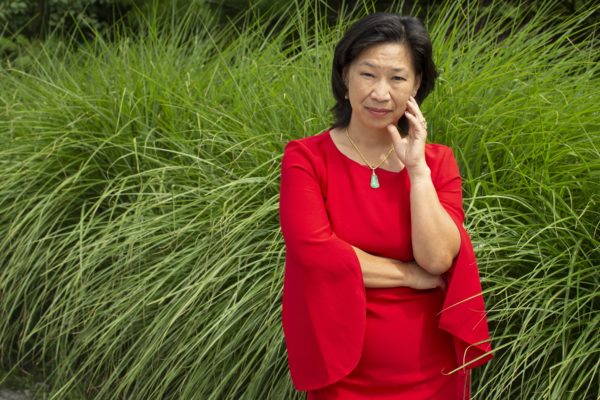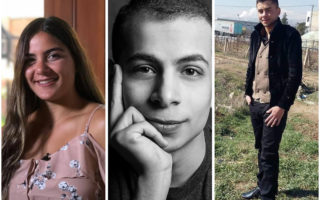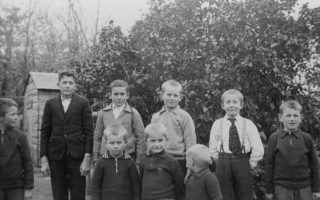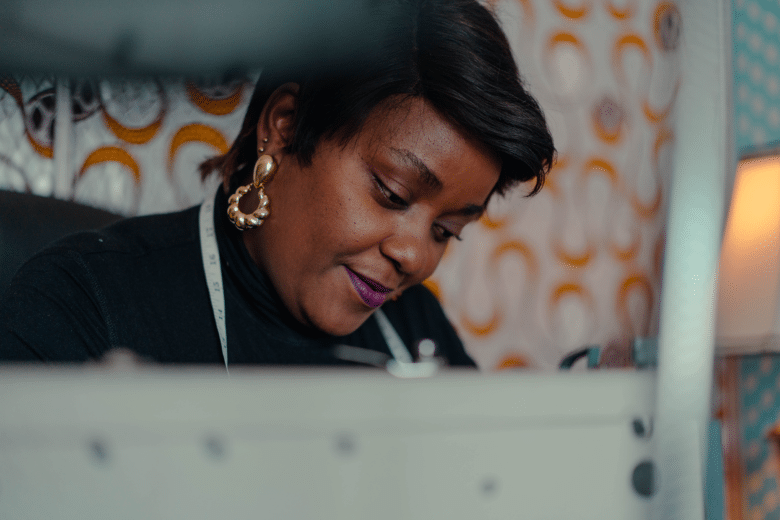
Espérance sits at her workstation as she gets to work on her latest creative fashion piece. ©UNHCR/Ian Patterson
Congolese refugee designer introduces African fashions to small town in Ontario
By Sarah Bilson
Could Espérance “Esperanza” Tabisha have imagined while she was sewing dresses from the Kakuma refugee camp in Kenya, that she would one day try to live her passion on the other side of the Atlantic?
We met virtually in September of 2021 – Espérance on her computer in Cambridge, Ontario, and I in Montreal, Quebec – to talk about her extraordinary journey from Congo to Canada.
Espérance welcomed me warmly, all dressed up in colourful fabrics and smiling. You could hear a house full of life around her and the babbling of her newborn twins before she embarked on her story.
In Kenya, Espérance was known for her entrepreneurial spirit — she ran a small but lively fashion and design business. Originally from the Democratic Republic of Congo, the 30-year-old mother had to flee her country in 2010 for security reasons.
She travelled by bus to Nairobi, passing by Rwanda. She then ended up in the Kakuma refugee camp in north-western Kenya. It is home to nearly 200,000 refugees; people who have fled war, violence, or persecution to find safety.
Building a new life one stitch at a time
As soon as she arrived at the camp, Espérance borrowed a sewing machine and got to work. With a background in fashion from the French Lycée Chemchem in Congo, she quickly started to sew and save money, motivated by her passion and talent for design. A year later, she bought her first machine and doubled her efforts by learning English — the only way to create a long-term relationship with her new clients.
“From people all over the camp, I was the only refugee who had a business online!”
She made custom dresses, shirts and outfits for her clientele of refugees, Kenyans and humanitarian workers from the neighbouring city. Thanks to the support of her husband who took care of their two children born in the camp, she decided to become an entrepreneur by creating her own fashion brand. “Esperanza Fashion & Design” was thus born, giving Espérance a means to feed her family.
Tabisha from DR Congo didn’t allow life as a refugee to dim her goals of becoming the ‘biggest fashion designer in Kakuma’.
She’s made a name for herself at Kakuma refugee camp in Kenya and dreams of dressing celebs like @YemiAladee with her stunning designs. pic.twitter.com/R91BgLdMYQ
— BBC News Africa (@BBCAfrica) July 10, 2019
In 2017, she came up with the idea of sharing her business on social media, to get known outside of the camp. She posted pictures of her various creations accompanied by hashtags.
“I opened a Facebook and Instagram page ‘Esperanza Fashion & Design’, then it went viral,” Espérance says cheerfully.
“From people all over the camp, I was the only refugee who had a business online!”
This new attention led to invitations to participate in conferences in Nairobi and interviews with international media outlets such as BBC Africa and French newspaper Le Monde. In 2018, she was selected to represent the Best Fashion Designer during a TEDx event taking place in the Kakuma camp.
Planting roots in Canada
In April 2019, the designer and her family received the opportunity to move to Canada thanks to a special program, known as the Blended Visa Office-Referred. The Canadian program helps refugees identified by the UNHCR to resettle in Canada, with the financial support of the Canadian government and a private sponsor.
“The resettlement program was all good. The Canadian government and sponsors were caring. The program is very excellent, it went so fast.”
Determined to expand her brand “Esperanza Fashion & Design” in a durable way, she and her family arrived in Canada in September of the same year.
“The resettlement program was all good. The Canadian government and sponsors were caring. The program is very excellent, it went so fast. [It] started all in April and in September we were in Canada,” she says.
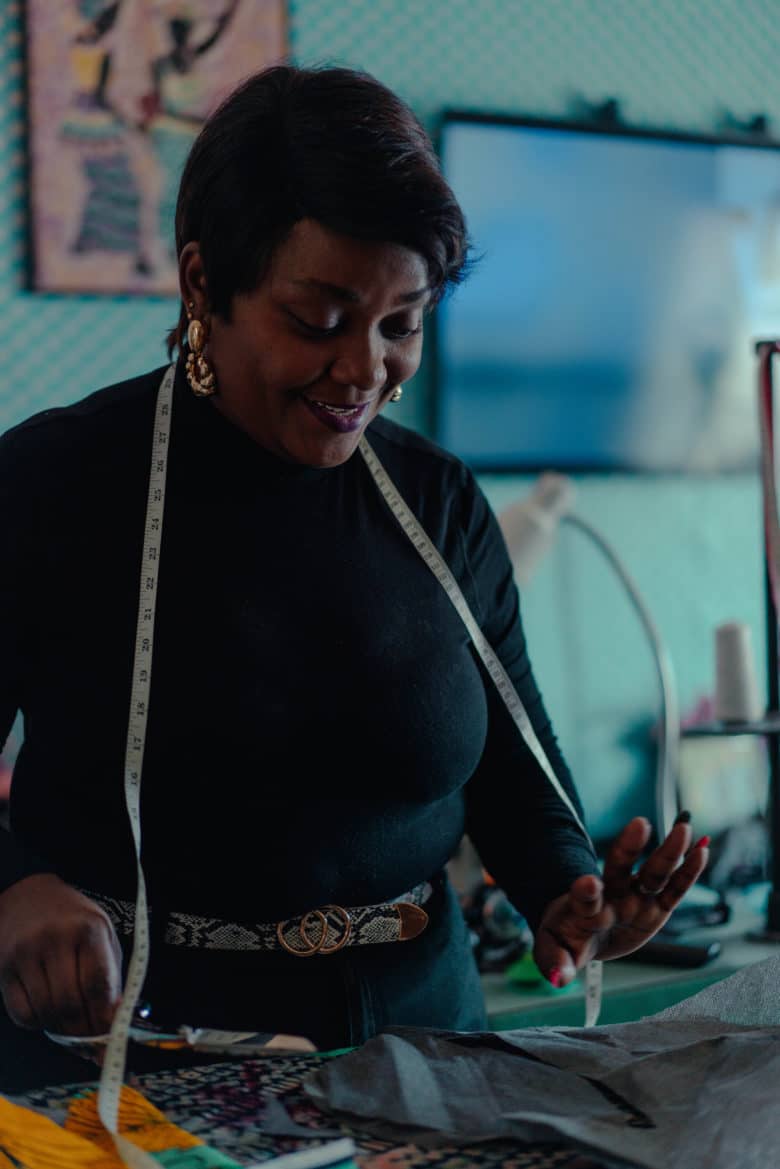
Espérance excitedly starts her newest project. ©UNHCR/Ian Patterson
Bewildered and happy at the same time, Espérance and her family were able to find a quiet place to stay where they felt comfortable right away: the small city of Cambridge, Ontario, about 90 kilometres southwest of Toronto. The family was able to count on the solidarity and openness of the people of the town, especially, the warm welcome of an Anglican church community.
“Canadians are so nice, very social, it’s easy to get along with them,” she adds.
True to her character, it didn’t take long for Espérance to plant new roots. One thing led to another, and she met people who advised her and introduced her to a community that was sensitive to her incredible journey from the camp. Seeing a woman full of determination, and a sense of style that left no doubt of her talent as a designer, the community rallied to help Espérance restart her business on Canadian soil.
“I have four sewing machines. Three domestic machines and one industrial machine. I had to spend no money for it, it was all a gift! I couldn’t say no!” she says.
An eager learner and businesswoman, Esperanza has since taken several opportunities to further her education by attending entrepreneurial programs at Conestoga College and a computer science class at the local YMCA, which offers programs for newcomers. This allowed her to benefit from the support of mentors and also to meet other women entrepreneurs and develop her network.
A uniquely Canadian fashion challenge
However, it was during her first winter months in Canada that her experience as a fashion designer took an important turn.
“There are so many challenges, the biggest difference with Africa is the weather! People can’t dress up the way they want to because of the weather!”
“I help myself by remembering my journey through the refugee camp, how I started: I didn’t know how to speak English, I didn’t know anything about business, now I know. Then coming here, I felt like life was giving me a second chance.”
With a ‘no problem, only solutions’ attitude, this apparent obstacle turned into a real catalyst for the designer. Espérance refined her business plan by focusing on an all-season collection. To that, she adds an essential asset: African printed fabrics. Espérance says the fabrics are the only thing she could bring from her former store in Kenya, as a point of departure for a new start in Canada.
“Most Africans dress up by wearing the same printed fabric from head to toe. I want to create something that Canadian, Caribbean, Asian, almost every culture, can be interested in wearing,” she says.
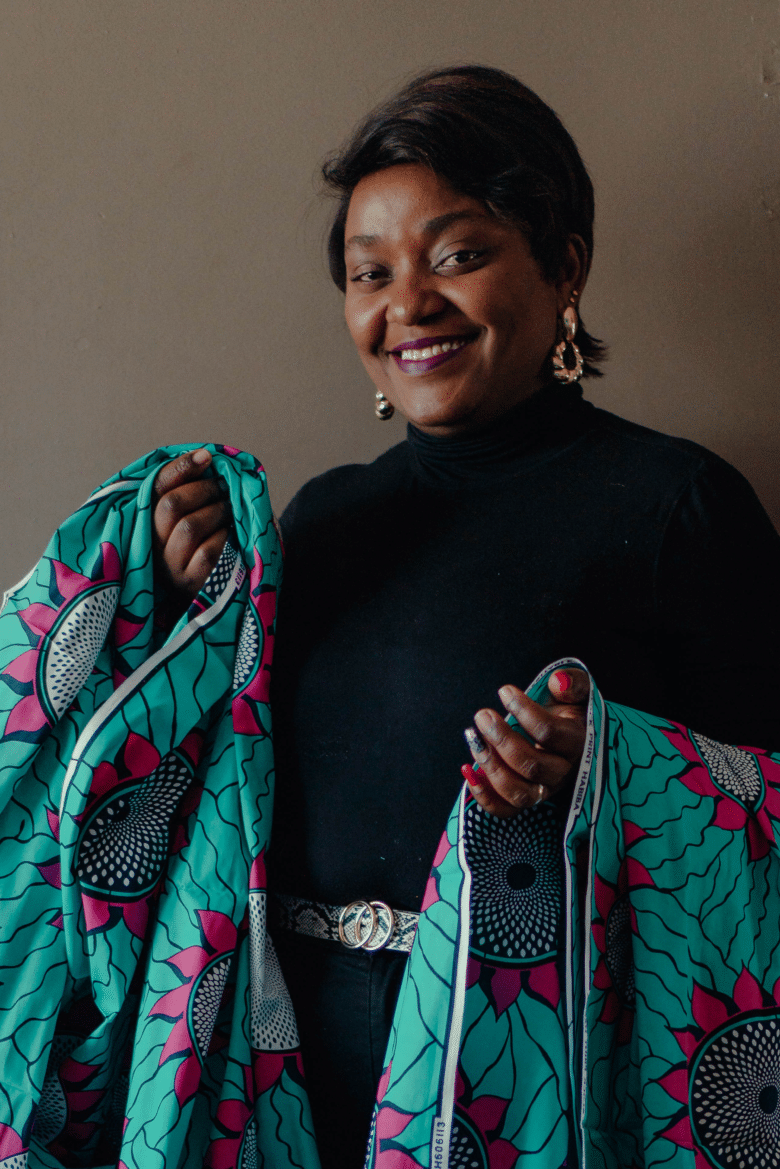
Espérance holds one of her favourite patterned fabrics. ©UNHCR/Ian Patterson
Yet like many Canadian entrepreneurs, Espérance was hit hard during the pandemic. It was a time when she was brainstorming ideas for a new collection that mixes Canadian and African culture and small accessories. When asked about those challenges, she remains optimistic, grateful for the progress made so far and confident about the next steps in her career.
“I know it might be hard but I’m keeping a positive mind,” she says. “I help myself by remembering my journey through the refugee camp, how I started: I didn’t know how to speak English, I didn’t know anything about business, now I know. Then coming here, I felt like life was giving me a second chance.”
Espérance’s time is divided between caring for her four children – including her six-month-old twins – and her online business. She does not hide her emotion and the joy of knowing that her children will be able to benefit from better education that would guarantee them a brighter future.
Driven, she is preparing her comeback with a more striking “Esperanza Fashion & Design”, which she wants to expand online. When asked about her dreams, she answers without hesitation.
“I want to ship my products across Canada and go back to the refugee camp as an ambassador for the UNHCR. […] I always want to give back to the community, to where I’m from, and I know that what I am today is thanks to the UNHCR, them who tried to pull me out.”
This story was produced by UPPL. With a Master’s degree in Archeology from Paris-Sorbonne, Sarah Bilson is a Montreal-based manager and facilitator working in the arts and cultural industry. You can find her on Instagram here.



